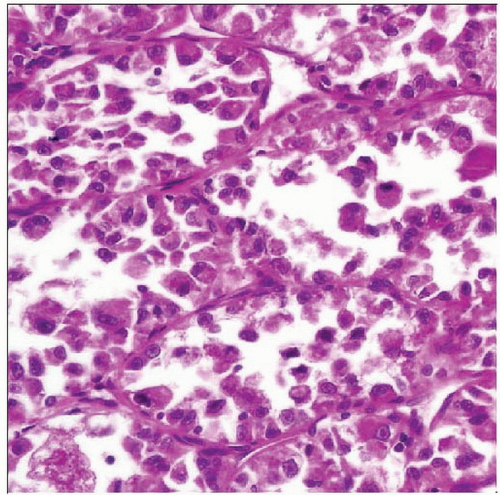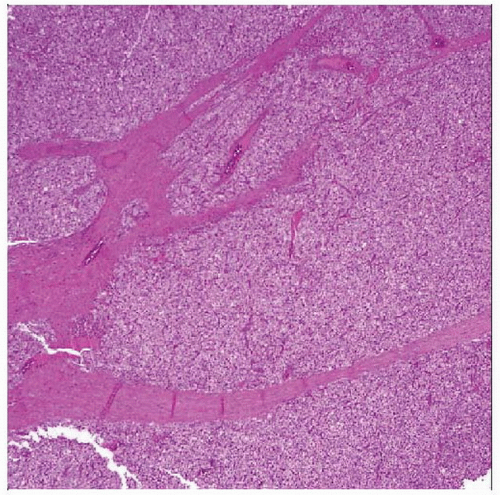Alveolar Soft Part Sarcoma
Julie C. Fanburg-Smith, MD
Aaron Auerbach, MD
Key Facts
Terminology
Alveolar soft part sarcoma (ASPS)
Malignant soft tissue tumor of uncertain phenotype that mainly affects young adults and children
Clustering alveolar-like growth pattern, separated by fibrous septa
Clinical Issues
Intramuscular
Hemorrhage
Lymphatic invasion
Deceptively indolent course
Distant metastasis
To lung bone and brain
Present in 25%
Microscopic Pathology
Solid type: Most common in infants in tongue and eye
Alveolar type: More common than solid type, usually buttocks, thigh in older child
High vascularity
PAS(+), diastase-resistant granular to crystalline cytoplasmic material, varies from few to all cells
Vimentin(-), desmin focally positive, MYOD1(-) (always cytoplasmic)
S100, keratins, CD34 all negative
TFE3(+)
Diagnostic Checklist
PAS(+) diastase-resistant granular to crystalline material is present in all cases (< 5-100% of cells)
TERMINOLOGY
Abbreviations
Alveolar soft part sarcoma (ASPS)
Definitions
Malignant soft tissue tumor of uncertain phenotype that mainly affects young adults and children
Clustering alveolar-like growth pattern, separated by fibrous septa
CLINICAL ISSUES
Presentation
Painless mass
Intramuscular
Hemorrhage
Lymphatic invasion
Prognosis
Deceptively indolent course
Distant metastasis to lung, bone, and brain present in 25%
Late recurrence and metastasis common
˜ 60% of patients have distant metastases
5-year survival rate is 65%
MICROSCOPIC PATHOLOGY
Histologic Features
Solid type: Most common in infants in tongue and eye
Solid pattern
Sheets of polygonal cells
Separated by fibrous septa
Alveolar type: More common than solid type, usually buttocks, thigh in older child
Alveolar pattern
Polygonal cells separated into nests by fibrovascular septa
Cells slough into center of “alveolus”
Eosinophilic cytoplasm
Eccentric nuclei with prominent nucleoli
Cytologic atypia rare
Mitotic activity low
High vascularity
Vascular/lymphatic invasion almost always present
Metastases to lung, bone, and brain
Stay updated, free articles. Join our Telegram channel

Full access? Get Clinical Tree




